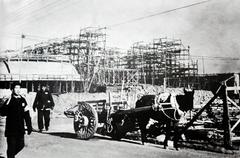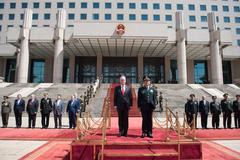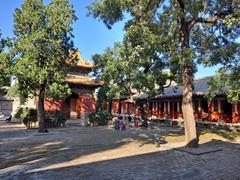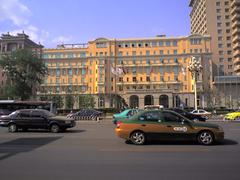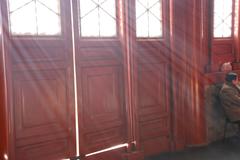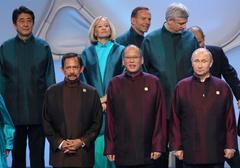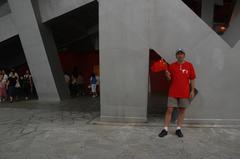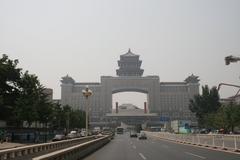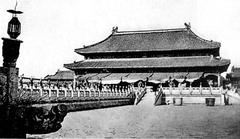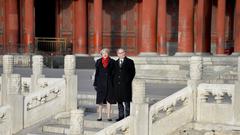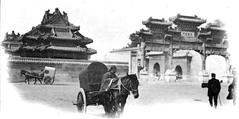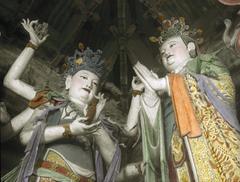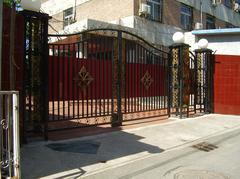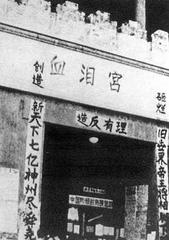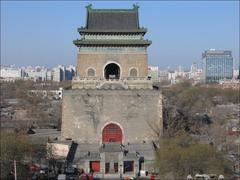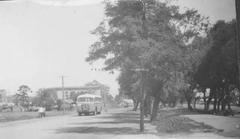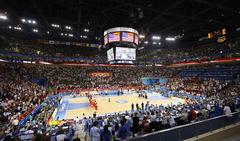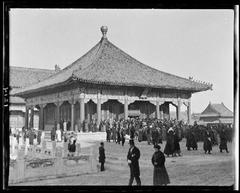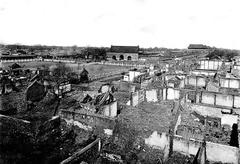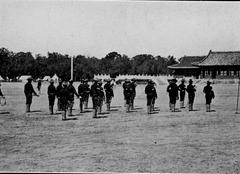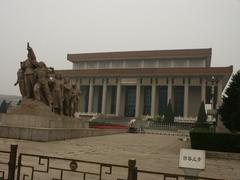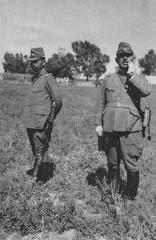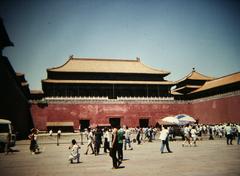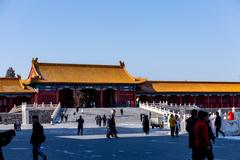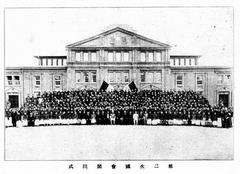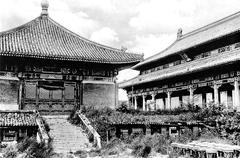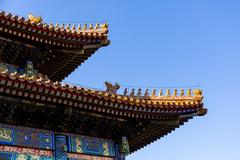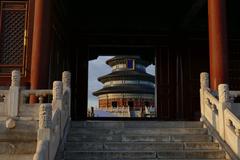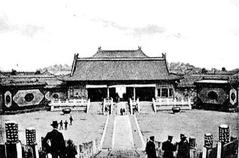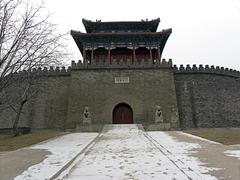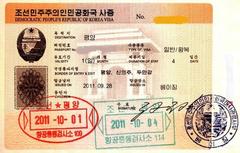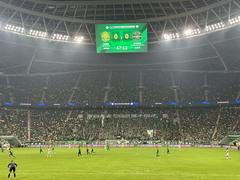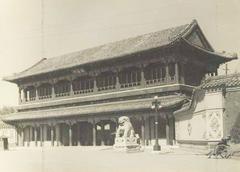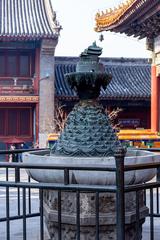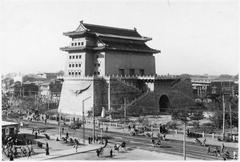
बीजिंग में बेदाग गर्भाधान कैथेड्रल: आगंतुकों के घंटे, टिकट और यात्रा गाइड
दिनांक: 07/03/2025
परिचय
बीजिंग का बेदाग गर्भाधान कैथेड्रल, जिसे आमतौर पर ज़ुआनवुमेन चर्च या नांतांग (“दक्षिण चर्च”) के नाम से जाना जाता है, बीजिंग का सबसे पुराना कैथोलिक चर्च है और धार्मिक, सांस्कृतिक और वास्तुशिल्प विरासत का एक स्थायी प्रतीक है। 1605 में मिंग राजवंश के दौरान इतालवी जेसुइट माटेओ रिक्की द्वारा स्थापित, यह कैथेड्रल चीन और पश्चिम के बीच शुरुआती आदान-प्रदान का एक प्रमाण है (विकिपीडिया)। यह मार्गदर्शिका कैथेड्रल के इतिहास, वास्तुकला, आगंतुक घंटों, टिकट नीतियों, पहुंच और व्यावहारिक युक्तियों पर व्यापक जानकारी प्रदान करती है, जो सभी प्रकार के आगंतुकों के लिए एक पुरस्कृत अनुभव सुनिश्चित करती है।
विषय सूची
- प्रारंभिक इतिहास और जेसुइट नींव
- विकास, संरक्षण और लचीलापन
- वास्तुशिल्प मुख्य अंश
- आगंतुक जानकारी
- आस-पास के आकर्षण
- अक्सर पूछे जाने वाले प्रश्न (FAQ)
- निष्कर्ष और आगंतुक सिफ़ारिशें
- संदर्भ
प्रारंभिक इतिहास और जेसुइट नींव
बेदाग गर्भाधान कैथेड्रल की जड़ें 1605 तक जाती हैं, जब माटेओ रिक्की, एक अग्रणी इतालवी जेसुइट, को बीजिंग में एक चैपल स्थापित करने की अनुमति मिली थी। चीनी रीति-रिवाजों को अपनाते हुए और शाही दरबार के साथ जुड़ते हुए, रिक्की ने शहर में एक स्थायी कैथोलिक उपस्थिति की नींव रखी। चर्च का प्रारंभिक डिज़ाइन पारंपरिक चीनी शैलियों को दर्शाता था, जो सम्मान और सांस्कृतिक एकीकरण का प्रतीक था।
विकास, संरक्षण और लचीलापन
किंग राजवंश के तहत, कैथेड्रल को शाही समर्थन से ख्याति मिली। 1650 में, जर्मन जेसुइट जोहान एडम शैल वॉन बेल ने शुनज़ी सम्राट के समर्थन से एक बड़ा चर्च बनाया। कैथेड्रल भूकंप, आग, दमन और विनाश से बच गया—विशेष रूप से 1900 के बॉक्सर विद्रोह के दौरान। हर बार, इसे फिर से बनाया गया, जिसने इसके महत्व और लचीलेपन को रेखांकित किया।
वर्तमान बारोक रिवाइवल संरचना, जिसे 1904 में पूरा किया गया था, चीनी रूपांकनों के साथ पश्चिमी चर्च रूपों का सामंजस्यपूर्ण मिश्रण करती है। माटेओ रिक्की और संत फ्रांसिस जेवियर की मूर्तियां, साथ ही चीनी भाषा में “हे मैरी” जैसे शिलालेख, इसके अद्वितीय सांस्कृतिक संश्लेषण को उजागर करते हैं (आरवी एशिया; बीजिंग घूमें)।
वास्तुशिल्प मुख्य अंश
बाहरी और मुखौटा
कैथेड्रल के प्रभावशाली मुखौटे में दोहरी घंटाघर, एक केंद्रीय गुलाब खिड़की और विस्तृत पत्थर की नक्काशी है जो पश्चिमी पुष्प पैटर्न को चीनी बादल और कमल रूपांकनों के साथ जोड़ती है। स्थानीय स्तर पर प्राप्त ग्रे ईंटों और लाल-ईंट एक्सेंट का उपयोग यूरोपीय और बीजिंग वास्तुशिल्प परंपराओं दोनों को दर्शाता है।
आंतरिक कलाकृतियाँ
अंदर, भव्य नाभि को यूरोप से आयात की गई विशद रंगीन कांच की खिड़कियों से रोशन किया गया है, जो मसीह और वर्जिन मैरी के जीवन के दृश्यों को दर्शाती हैं। गुंबददार छतें, संगमरमर की वेदी और सोने की लकड़ी एक श्रद्धा का माहौल बनाते हैं। साइड चैपल और ऐतिहासिक पाइप अंग कैथेड्रल के आध्यात्मिक और कलात्मक माहौल को बढ़ाते हैं।
आगंतुक जानकारी
स्थान और पहुंच
- पता: नंबर 141, कियानमेन वेस्ट स्ट्रीट, शिफेंग जिला, बीजिंग
- सबवे: ज़ुआनवुमेन स्टेशन (लाइन 2 और 4), एग्जिट बी, कैथेड्रल प्रवेश द्वार से 200 मीटर दूर
- पार्किंग: सीमित; सार्वजनिक परिवहन की सलाह दी जाती है
आगंतुक घंटे
- सामान्य घंटे: प्रतिदिन सुबह 7:00 बजे से शाम 5:00 बजे तक (धार्मिक त्योहारों और विशेष आयोजनों के दौरान भिन्न हो सकते हैं)
- रविवार मास: सुबह 6:00, 7:00, 8:30, 10:00 बजे (अंग्रेजी: सुबह 10:00 बजे और दोपहर 4:00 बजे)
- सप्ताह के दिनों में मास: सुबह जल्दी; मौसमी भिन्नताओं के लिए जांचें (द बीजिंगर)
टिकट और प्रवेश
- प्रवेश: सभी आगंतुकों के लिए निःशुल्क; रखरखाव और सामुदायिक गतिविधियों का समर्थन करने के लिए दान की सराहना की जाती है
- ड्रेस कोड: मामूली पोशाक आवश्यक है (कंधे और घुटने ढके हुए; प्रवेश पर टोपी हटा दी जाती है)
पहुंच
- गतिशीलता: कैथेड्रल आंशिक रूप से सुलभ है। मुख्य प्रवेश द्वार पर अनुरोध पर पोर्टेबल रैंप उपलब्ध हैं। चौड़ी गलियारे व्हीलचेयर के लिए उपयुक्त हैं, लेकिन साइड चैपल में सीमित पहुंच हो सकती है।
- शौचालय: साइट पर उपलब्ध नहीं हैं; ज़ुआनवुमेन सबवे स्टेशन पर सार्वजनिक सुविधाएं पास में हैं।
गाइडेड टूर
- नियमित गाइडेड टूर मानक नहीं हैं, लेकिन रविवार के मास के बाद अंग्रेजी बोलने वाले स्वयंसेवक मौजूद हो सकते हैं। वास्तुकला और इतिहास के बारे में पृष्ठभूमि प्रदान करने वाले चीनी और अंग्रेजी में सूचनात्मक पट्टिकाएं। ऑडियो गाइड और अतिरिक्त संसाधन ऑनलाइन उपलब्ध हैं (आधिकारिक सूबा वेबसाइट)।
फोटोग्राफी और आगंतुक शिष्टाचार
- फोटोग्राफी: मास के दौरान को छोड़कर, फ्लैश के बिना अनुमति है। फ्लैश और तिपाई के लिए अनुमति की आवश्यकता हो सकती है।
- शिष्टाचार: चुप्पी बनाए रखें या धीरे बोलें, खासकर मास के दौरान। पादरी का अभिवादन करते समय थोड़ा झुकें और सहमति के बिना व्यक्तियों की तस्वीरें लेने से बचें।
आस-पास के आकर्षण
कैथेड्रल का केंद्रीय स्थान इसे बीजिंग के ऐतिहासिक और सांस्कृतिक स्थलों की खोज के लिए एक आदर्श प्रारंभिक बिंदु बनाता है:
- तियानमेन स्क्वायर
- फॉरबिडन सिटी
- बेईहाई पार्क
- कियानमेन स्ट्रीट
- माउंट कार्मेल (शिटैंग) का चर्च
विविध भोजन विकल्प, दुकानें और एटीएम पैदल दूरी पर हैं। रविवार को स्थानीय विक्रेताओं द्वारा कभी-कभी धार्मिक स्मृति चिन्ह बेचे जाते हैं।
अक्सर पूछे जाने वाले प्रश्न (FAQ)
प्रश्न: क्या बेदाग गर्भाधान कैथेड्रल में प्रवेश के लिए टिकट की आवश्यकता है? ए: नहीं, प्रवेश निःशुल्क है।
प्रश्न: कैथेड्रल के आगंतुक घंटे क्या हैं? ए: आम तौर पर प्रतिदिन सुबह 7:00 बजे से शाम 5:00 बजे तक खुला रहता है; मास का समय भिन्न होता है।
प्रश्न: क्या कैथेड्रल गतिशीलता चुनौतियों वाले आगंतुकों के लिए सुलभ है? ए: आंशिक रूप से। मुख्य प्रवेश द्वार पर सीढ़ियाँ हैं, लेकिन पोर्टेबल रैंप उपलब्ध हैं; कुछ क्षेत्रों में सीमित पहुंच है।
प्रश्न: क्या अंग्रेजी में गाइडेड टूर उपलब्ध हैं? ए: नियमित रूप से नहीं, लेकिन रविवार के मास के बाद अंग्रेजी बोलने वाले स्वयंसेवक सहायता कर सकते हैं।
प्रश्न: क्या मैं अंदर तस्वीरें ले सकता हूँ? ए: हाँ, फ्लैश के बिना और मास के दौरान नहीं।
प्रश्न: कैथेड्रल कैसे पहुँचें? ए: बीजिंग सबवे से ज़ुआनवुमेन स्टेशन (लाइन 2 या 4), एग्जिट बी पर जाएँ।
निष्कर्ष और आगंतुक सिफ़ारिशें
बेदाग गर्भाधान कैथेड्रल बीजिंग के जटिल इतिहास, आस्था और कलात्मक उपलब्धि के एक जीवित स्मारक के रूप में खड़ा है। इसकी बारोक रिवाइवल वास्तुकला, चीनी रूपांकनों का सामंजस्यपूर्ण एकीकरण और जीवंत सामुदायिक जीवन इसे यात्रियों, इतिहास प्रेमियों और वास्तुकला के प्रति उत्साही लोगों के लिए एक अवश्य देखने योग्य स्थल बनाता है (विकिपीडिया; आरवी एशिया; बीजिंग घूमें; द बीजिंगर)।
अपनी यात्रा को अधिकतम करने के लिए:
- अपनी यात्रा से पहले वर्तमान आगंतुक घंटों और मास शेड्यूल की पुष्टि करें।
- सुविधा के लिए सार्वजनिक पारगमन का उपयोग करें।
- अपनी यात्रा को अन्य आस-पास के सांस्कृतिक आकर्षणों के साथ मिलाएं।
- विनम्रता से कपड़े पहनें और स्थानीय रीति-रिवाजों और धार्मिक प्रथाओं का सम्मान करें।
ऑडियला ऐप डाउनलोड करके और हमारे सोशल मीडिया चैनलों को फॉलो करके नवीनतम समाचारों और यात्रा युक्तियों से अपडेट रहें।
संदर्भ
- बेदाग गर्भाधान कैथेड्रल, बीजिंग – विकिपीडिया
- बेदाग गर्भाधान कैथेड्रल – चीन का सबसे पुराना कैथोलिक चर्च – आरवी एशिया
- बीजिंग घूमें – बेदाग गर्भाधान कैथेड्रल
- ज़ुआनवुमेन चर्च (दक्षिण चर्च / नांतांग) – द बीजिंगर
ऑडियला2024{‘date’: ‘03/07/2025’, ‘task’: {‘model’: ‘gpt-4.1-mini’, ‘query’: “Comprehensive guide to visiting Cathedral Of The Immaculate Conception, Beijing, People’s Republic of China: history, significance, visitor tips, and everything tourists need to know for a memorable experience.”, ‘verbose’: False, ‘guidelines’: [“Keyword Research: Identify relevant keywords that potential visitors are likely to search for, such as ‘[Monument Name] visiting hours,’ ‘[Monument Name] tickets,’ and ‘[City] historical sites.’ Use these keywords strategically throughout the article, including in the title, headers, and body text, but avoid keyword stuffing.”, ‘Engaging and Informative Title: Craft a title that is both SEO-friendly and compelling to encourage clicks. Include the main keyword and make it clear what the article will cover.’, ‘Structured Content: Use headings (H1, H2, H3) to organize the content effectively. This helps with SEO and makes the article easier for readers to navigate. Include an introduction that hooks the reader, a detailed body that covers all relevant aspects, and a conclusion that summarizes the key points.’, ‘Comprehensive Coverage: Address common questions and topics of interest such as the history of the monument, its cultural significance, visitor information (e.g., ticket prices, opening hours), travel tips, nearby attractions, and accessibility. Include sections that might be unique to the monument, like special events, guided tours, and photographic spots.’, ‘Quality Content: Ensure the content is well-researched, accurate, and provides real value to readers. Use reliable sources and provide factual information. Write in a clear, engaging, and accessible style. Consider your audience and use language that is appropriate for those likely to visit the monument.’, ‘Visuals and Media: Incorporate high-quality images or videos of the monument. These should be optimized for the web (correct sizing, alt tags with keywords). Consider interactive elements like virtual tours or maps.’, ‘Internal and External Links: Include links to other related articles on your site to encourage deeper engagement (internal links). Link to official websites for the monument or credible sources for further reading (external links).’, ‘FAQ: Incorporate FAQ sections to target voice search queries and featured snippets’, ‘Visit and Stay Up to Date: End the article with a call to action, such as encouraging readers to download our mobile app Audiala, check out other related posts, or follow on social media for more updates.’], ‘max_sections’: 4, ‘publish_formats’: {‘pdf’: False, ‘docx’: False, ‘markdown’: True}, ‘follow_guidelines’: True}, ‘title’: “Comprehensive Guide to Visiting the Cathedral of the Immaculate Conception, Beijing, People’s Republic of China”, ‘report’: ’# Cathedral of the Immaculate Conception Beijing: Visiting Hours, Tickets, and Travel Guide\n\n#### Date: 03/07/2025\n\n## Introduction\n\nThe Cathedral of the Immaculate Conception in Beijing, also known as Xuanwumen Catholic Church or Nantang (“South Church”), is the oldest Catholic church in Beijing and a significant landmark in China’s religious and cultural history. This article provides an in-depth look at the cathedral’s historical roots, architectural symbolism, and its role in Sino-Western relations, alongside practical visitor information including visiting hours, ticketing, travel tips, and nearby attractions. Whether you’re a history enthusiast, a religious pilgrim, or a traveler exploring Beijing historical sites, this guide will help you make the most of your visit.\n\n## Historical Roots and Evolution of Religious Practice\n\nFounded in 1605 during the Ming dynasty under the Wanli Emperor, the cathedral’s origins trace to Italian Jesuit Matteo Ricci’s residence in Beijing, which included the city’s first formal Catholic chapel (Wikipedia). The church gained imperial favor during the Qing dynasty, notably with the Shunzhi Emperor’s support in 1650, leading to the construction of a new church on the original site. Elevated to cathedral status by 1690, it withstood natural disasters and political upheavals, culminating in the current Baroque-style building completed in 1904 (RV Asia).\n\n## Architectural Symbolism and Syncretism\n\nThe cathedral’s architecture reflects a unique fusion of Western Baroque style and Chinese cultural elements. The façade features the coat of arms of Pope Pius X and symbols of the Virgin Mary alongside a traditional Chinese-style gate. Inside, the stained glass windows, semi-circular nave, and altar with Catholic icons create a spiritual ambiance complemented by historical Jesuit scientific artifacts on the grounds (Visit Beijing).\n\n## Role in the Spread of Catholicism and Sino-Western Relations\n\nServing as the epicenter of Catholic missionary work in Beijing, the cathedral was instrumental in introducing Western religious thought and science to China. Imperial support from Qing emperors, including financial donations and ceremonial honors, highlights its role as a bridge between Chinese tradition and Western Christianity (Wikipedia). Despite challenges like the Boxer Rebellion and the Cultural Revolution, the cathedral remains a symbol of endurance for the Catholic faith in China.\n\n## Contemporary Religious Life and Community\n\nToday, the cathedral offers Mass in multiple languages including Chinese, English, Italian, Spanish, and Latin, serving a diverse local and international congregation (Visit Beijing). Major religious celebrations at Easter and Christmas draw large crowds and feature concerts and community events, fostering intercultural dialogue (Trip.com).\n\n## Visiting Information for Travelers\n\n### Visiting Hours and Tickets\n- Hours: Typically open from 7:00 AM to 6:00 PM daily; however, hours may vary during special events or renovations.\n- Tickets: Admission is generally free. Donations are welcomed to support maintenance and community programs.\n\n### Accessibility\nThe cathedral is wheelchair accessible with ramps at the main entrance and accessible restroom facilities.\n\n### Guided Tours and Facilities\nGuided tours are available for visitors interested in the cathedral’s history and architecture. Audio guides and printed brochures in multiple languages can be obtained at the visitor center.\n\n### Photography and Visitor Etiquette\nPhotography is permitted in most areas; however, flash photography is discouraged inside the sanctuary to maintain reverence.\n\n## Nearby Attractions and Travel Tips\n\nThe cathedral is conveniently located near Beijing’s major landmarks such as Tiananmen Square and the National Museum of China, making it an ideal stop on a Beijing historical sites tour. Visitors can explore local shops selling religious items in the churchyard and enjoy nearby cafes.\n\n### Travel Tips\n- Visit early in the morning or late afternoon to avoid peak crowds.\n- Check the cathedral’s official website or contact the visitor center for the latest updates on visiting hours and special events.\n- Combine your visit with nearby attractions for a full day of cultural exploration.\n\n## Frequently Asked Questions (FAQ)\n\nQ: Is there an entrance fee for the Cathedral of the Immaculate Conception?\nA: Admission is free, but donations are accepted.\n\nQ: What are the cathedral’s visiting hours?\nA: Usually from 7:00 AM to 6:00 PM daily, subject to change.\n\nQ: Are guided tours available?\nA: Yes, guided tours and audio guides are offered.\n\nQ: Is the cathedral wheelchair accessible?\nA: Yes, the cathedral has ramps and accessible restrooms.\n\nQ: Can I attend Mass in English?\nA: Yes, English Masses are regularly held, especially popular among expatriates.\n\n## Conclusion and Call to Action\n\nThe Cathedral of the Immaculate Conception in Beijing is not only a historic religious site but also a vibrant center for cultural exchange and spiritual life. Whether you are visiting for its rich history, architectural beauty, or religious services, the cathedral offers a unique glimpse into Beijing’s multicultural heritage.\n\nPlan your visit today and immerse yourself in this captivating site. For the latest updates on visiting hours, guided tours, and special events, download the Audiala mobile app. Don’t forget to explore our related posts on Beijing historical sites and follow us on social media for more travel tips and cultural stories.\n\n---\n\nImages, maps, and videos related to the Cathedral of the Immaculate Conception Beijing can be found on the official tourism website and through linked resources. Alt tags for images should include keywords such as “Cathedral of the Immaculate Conception visiting hours,” “Beijing historical sites,” and “Cathedral of the Immaculate Conception tickets” to enhance SEO.\n\n’, ‘headers’: {‘date’: ‘Date’, ‘title’: ‘Cathedral of the Immaculate Conception Beijing Visiting Hours Tickets and Travel Guide’, ‘conclusion’: ‘Summary and Visitor Recommendations for the Cathedral of the Immaculate Conception’, ‘references’: ‘References and Further Reading’, ‘introduction’: ‘Introduction to the Cathedral of the Immaculate Conception in Beijing’, ‘table_of_contents’: ‘Table of Contents’}, ‘sources’: [’- Cathedral of the Immaculate Conception, Beijing - Wikipedia. (n.d.). https://en.wikipedia.org/wiki/Cathedral_of_the_Immaculate_Conception,_Beijing’, ’- Cathedral of the Immaculate Conception – Oldest Catholic Church in China – RV Asia. (n.d.). https://www.rvasia.org/feature-story/cathedral-immaculate-conception-oldest-catholic-church-china’, ’- Visit Beijing – Cathedral of the Immaculate Conception. (n.d.). https://english.visitbeijing.com.cn/article/47OMk0NLEp5’, ’- Xuanwumen Church (South Church / Nantang) – The Beijinger. (n.d.). https://www.thebeijinger.com/directory/xuanwumen-church-south-church-nantang’], ‘sections’: [‘Historical Overview’, ‘Cultural and Religious Significance’, ‘Architectural Highlights’, ‘Visitor Experience and Practical Tips’], ‘conclusion’: “The Cathedral of the Immaculate Conception in Beijing stands as a remarkable emblem of faith, cultural resilience, and architectural splendor. From its pioneering Jesuit origins in the early 17th century to its present-day role as a vibrant center for worship and community, the cathedral encapsulates centuries of Sino-Western exchange and religious history. Visitors are drawn not only to its stunning Baroque revival architecture, which harmoniously blends Western and Chinese artistic elements, but also to its ongoing spiritual and cultural significance within Beijing’s diverse community (Wikipedia; RV Asia).\n\nIts accessibility near major public transport hubs, free admission, and multilingual Mass services make it an inviting destination for both local worshippers and international travelers. The cathedral’s proximity to prominent historical sites such as Tiananmen Square and Beihai Park offers visitors the opportunity to immerse themselves in Beijing’s rich heritage fully. Whether attending a Mass, admiring the intricate stained glass, or simply reflecting in the serene nave, every visitor can appreciate the cathedral’s unique blend of history, art, and spirituality.\n\nTo plan your visit effectively, be sure to check current visiting hours and available guided tours, and consider exploring nearby attractions to enrich your cultural itinerary. For ongoing updates, travel tips, and immersive experiences, downloading the Audiala app and following social media channels dedicated to Beijing’s historical landmarks is highly recommended.\n\nEmbrace the chance to explore this iconic monument, a living bridge between East and West, and a timeless beacon of faith in the heart of Beijing (Visit Beijing; The Beijinger).”, ‘introduction’: ‘The Cathedral of the Immaculate Conception in Beijing, often referred to as Xuanwumen Catholic Church or Nantang (“South Church”), stands as a profound testament to over four centuries of religious, cultural, and architectural history in China’s capital. Established in 1605 by the Italian Jesuit missionary Matteo Ricci during the Ming dynasty, it represents the earliest enduring Catholic presence in Beijing and serves as a vital symbol of Sino-Western cultural exchange (Wikipedia).\n\nThis cathedral’s rich narrative unfolds through its multiple reconstructions, imperial patronage under the Qing dynasty, and resilience through periods of political upheaval including the Boxer Rebellion and the Cultural Revolution. The current Baroque revival structure, completed in 1904, beautifully integrates Western ecclesiastical design with Chinese architectural motifs, reflecting a unique fusion that exemplifies the adaptability of Catholic architecture within a local context (RV Asia; Visit Beijing).\n\nToday, the cathedral is not only Beijing’s oldest Catholic church but also an active hub for worship, community events, and intercultural dialogue, offering Masses in multiple languages including Chinese, English, Italian, and French. Its location near Xuanwumen subway station in the Xicheng District makes it highly accessible for travelers seeking to explore Beijing’s religious heritage alongside nearby historical landmarks such as Tiananmen Square and the Forbidden City (The Beijinger).\n\nWhether you are a history enthusiast, architecture admirer, religious pilgrim, or cultural traveler, this comprehensive guide will equip you with essential information on visiting hours, ticket policies, accessibility, guided tours, and practical tips, ensuring a rewarding experience at one of Beijing’s most cherished historic sites.’, ‘research_data’: [{‘Cathedral of the Immaculate Conception Beijing: History, Visiting Hours, and Tips for Visitors’: ’## Introduction\n\nThe Cathedral of the Immaculate Conception in Beijing, also known as Xuanwumen Catholic Church or Nantang (“South Church”), stands as a remarkable historical and religious landmark. This article explores its rich history, cultural significance, architectural beauty, and provides practical information for visitors, including visiting hours, ticket details, accessibility, and nearby attractions. Whether you are a history enthusiast, a religious pilgrim, or a curious traveler, this guide will help you make the most of your visit to one of Beijing’s most cherished historical sites.\n\n## Early Foundations and Jesuit Beginnings (1605–1650)\n\nThe origins of the Cathedral trace back to 1605, when Italian Jesuit missionary Matteo Ricci was granted permission to reside in Beijing during the Ming dynasty. Ricci established a small chapel near Xuanwumen in traditional Chinese style, marking the start of a lasting Catholic presence. His respectful adoption of Chinese customs fostered acceptance among locals and the imperial court.\n\n## Expansion and Imperial Patronage (1650–1775)\n\nUnder the Qing dynasty, the cathedral grew with imperial support. German Jesuit Johann Adam Schall von Bell led the construction of a larger church in 1650, honored by the Shunzhi Emperor. Subsequent enlargements and renovations, including Baroque-style designs, faced challenges from earthquakes and fires but were consistently restored with imperial patronage, highlighting the cathedral’s importance.\n\n## Suppression, Reopening, and Destruction (1838–1900)\n\nThe 19th century brought political challenges. The cathedral was confiscated in 1838 but reopened after the Second Opium War in 1860. However, it was destroyed during the Boxer Rebellion in 1900 amid anti-Christian violence.\n\n## The Present Structure: Baroque Revival (1904–Present)\n\nThe current Baroque-style cathedral, completed in 1904, is the fourth on the site. It features a cruciform layout, ornate facades, and a unique blend of Western and Chinese elements. Statues of Matteo Ricci and Saint Francis Xavier, as well as a rockery altar inscribed with “Hail Mary” in Chinese, enhance the visitor experience.\n\n## Cultural Significance and Community Role\n\nAs Beijing’s oldest Catholic church, the cathedral has been central to the city’s religious and cultural life. It remains the seat of the Beijing Diocese and hosts Masses in multiple languages, including Chinese, English, Italian, and French, serving a diverse community. The cathedral also holds community events and educational exhibitions.\n\n## Modern Era: Survival, Restoration, and Recognition\n\nDespite suspensions during the Cultural Revolution, the cathedral revived in 1979 and is now recognized by both the Chinese Patriotic Catholic Association and the Vatican. Ongoing restoration preserves its status as a protected historic site and a symbol of faith and cultural exchange.\n\n## Architectural Features and Visitor Experience\n\nThe cathedral’s grand nave, stained glass windows, and fusion of Chinese and Western motifs offer a unique insight into Christianity’s history in China. Visitors can appreciate statues, inscriptions, and the rockery altar, all contributing to a memorable visit.\n\n## Visiting Information\n\n- Visiting Hours: The cathedral is generally open daily from 7:00 AM to 5:00 PM. It is advisable to check ahead during holidays or special events.\n- Entry Fees: Admission is free, but donations are welcome to support maintenance and community activities.\n- Guided Tours: Guided tours are available in multiple languages, including English and Chinese. Visitors can join scheduled tours or arrange private guides through the cathedral office.\n- Accessibility: The cathedral is wheelchair accessible, with ramps and assistance available upon request.\n- Best Time to Visit: Early mornings and weekdays offer a quieter experience. Special services and festivals provide unique cultural insights.\n- How to Get There: Located near Xuanwumen in Beijing’s Xicheng District, the cathedral is accessible via public transport—Xuanwumen Metro Station (Line 2 and Line 4) is the closest stop. Taxis and buses also serve the area.\n- Photography: Photography is allowed inside and outside, but flash and tripods are discouraged to preserve the artwork.\n\n## Nearby Attractions\n\nVisitors can explore nearby historical sites such as Beihai Park, the Forbidden City, and the Church of Our Lady of Mount Carmel (Xitang), enriching their cultural itinerary.\n\n## FAQ\n\nQ: What are the Cathedral of the Immaculate Conception Beijing visiting hours?\nA: The cathedral is open daily from 7:00 AM to 5:00 PM, but hours may vary during holidays.\n\nQ: Is there an entry fee or Cathedral tickets required?\nA: Entry is free; donations are accepted.\n\nQ: Are guided tours available?\nA: Yes, guided tours in English and Chinese are offered. Advanced booking is recommended.\n\nQ: Is the cathedral accessible for people with disabilities?\nA: Yes, wheelchair access and assistance are available.\n\nQ: What languages are Masses held in?\nA: Masses are conducted in Chinese, English, Italian, and French.\n\nQ: Can I take photographs inside the cathedral?\nA: Photography is permitted without flash or tripods.\n\n## Conclusion\n\nThe Cathedral of the Immaculate Conception in Beijing is not only a testament to centuries of faith and cultural exchange but also a vibrant center for worship and community life today. Whether you are visiting for its historical significance, architectural beauty, or religious services, the cathedral offers a welcoming and enriching experience.\n\nPlan your visit by checking the latest visiting hours and tour options, and explore nearby Beijing historical sites to fully appreciate the city’s rich heritage. For more travel tips and updates on cultural landmarks, be sure to download the Audiala app and follow our social media channels.\n\n---\n\nSuggested Visuals: High-quality images of the cathedral’s facade, interior nave, statues of Matteo Ricci and Saint Francis Xavier, and the rockery altar with alt tags such as “Cathedral of the Immaculate Conception Beijing facade” and “Inside the Cathedral of the Immaculate Conception Beijing.” Interactive maps and virtual tour links can enhance visitor planning.\n\nInternal Links: Consider linking to related articles such as “Top Historical Sites to Visit in Beijing” and “A Guide to Religious Architecture in China.”’}, {‘Cathedral of the Immaculate Conception Beijing: History, Visiting Hours, & Travel Tips’: ”## Introduction\n\nThe Cathedral of the Immaculate Conception in Beijing, also known as Xuanwumen Church or Nantang (South Church), is the oldest Catholic church in Beijing and a significant landmark in China’s religious and cultural history. This article provides an in-depth look at the cathedral’s historical roots, architectural symbolism, and its role in Sino-Western relations, alongside practical visitor information including visiting hours, ticketing, travel tips, and nearby attractions. Whether you’re a history enthusiast, a religious pilgrim, or a traveler exploring Beijing historical sites, this guide will help you make the most of your visit.\n\n## Historical Roots and Evolution of Religious Practice\n\nFounded in 1605 during the Ming dynasty under the Wanli Emperor, the cathedral’s origins trace to Italian Jesuit Matteo Ricci’s residence in Beijing, which included the city’s first formal Catholic chapel (Wikipedia). The church gained imperial favor during the Qing dynasty, notably with the Shunzhi Emperor’s support in 1650, leading to the construction of a new church on the original site. Elevated to cathedral status by 1690, it withstood natural disasters and political upheavals, culminating in the current Baroque-style building completed in 1904 (RV Asia).\n\n## Architectural Symbolism and Syncretism\n\nThe cathedral’s architecture reflects a unique fusion of Western Baroque style and Chinese cultural elements. The façade features the coat of arms of Pope Pius X and symbols of the Virgin Mary alongside a traditional Chinese-style gate. Inside, the stained glass windows, semi-circular nave, and altar with Catholic icons create a spiritual ambiance complemented by historical Jesuit scientific artifacts on the grounds (Visit Beijing).\n\n## Role in the Spread of Catholicism and Sino-Western Relations\n\nServing as the epicenter of Catholic missionary work in Beijing, the cathedral was instrumental in introducing Western religious thought and science to China. Imperial support from Qing emperors, including financial donations and ceremonial honors, highlights its role as a bridge between Chinese tradition and Western Christianity (Wikipedia). Despite challenges like the Boxer Rebellion and the Cultural Revolution, the cathedral remains a symbol of endurance for the Catholic faith in China.\n\n## Contemporary Religious Life and Community\n\nToday, the cathedral offers Mass in multiple languages including Chinese, English, Italian, Spanish, and Latin, serving a diverse local and international congregation (Visit Beijing). Major religious celebrations at Easter and Christmas draw large crowds and feature concerts and community events, fostering intercultural dialogue (Trip.com).\n\n## Visiting Information for Travelers\n\n### Visiting Hours and Tickets\n- Hours: Typically open from 7:00 AM to 6:00 PM daily; however, hours may vary during special events or renovations.\n- Tickets: Admission is generally free. Donations are welcomed to support maintenance and community programs.\n\n### Accessibility\nThe cathedral is wheelchair accessible with ramps at the main entrance and accessible restroom facilities.\n\n### Guided Tours and Facilities\nGuided tours are available for visitors interested in the cathedral’s history and architecture. Audio guides and printed brochures in multiple languages can be obtained at the visitor center.\n\n### Photography and Visitor Etiquette\nPhotography is permitted in most areas; however, flash photography is discouraged inside the sanctuary to maintain reverence.\n\n## Nearby Attractions and Travel Tips\n\nThe cathedral is conveniently located near Beijing’s major landmarks such as Tiananmen Square and the National Museum of China, making it an ideal stop on a Beijing historical sites tour. Visitors can explore local shops selling religious items in the churchyard and enjoy nearby cafes.\n\n### Travel Tips\n- Visit early in the morning or late afternoon to avoid peak crowds.\n- Check the cathedral’s official website or contact the visitor center for the latest updates on visiting hours and special events.\n- Combine your visit with nearby attractions for a full day of cultural exploration.\n\n## Frequently Asked Questions (FAQ)\n\nQ: Is there an entrance fee for the Cathedral of the Immaculate Conception?\nA: Admission is free, but donations are accepted.\n\nQ: What are the cathedral’s visiting hours?\nA: Usually from 7:00 AM to 6:00 PM daily, subject to change.\n\nQ: Are guided tours available?\nA: Yes, guided tours and audio guides are offered.\n\nQ: Is the cathedral wheelchair accessible?\nA: Yes, the cathedral has ramps and accessible restrooms.\n\nQ: Can I attend Mass in English?\nA: Yes, English Masses are regularly held, especially popular among expatriates.\n\n## Conclusion and Call to Action\n\nThe Cathedral of the Immaculate Conception in Beijing is not only a historic religious site but also a vibrant center for cultural exchange and spiritual life. Whether you are visiting for its rich history, architectural beauty, or religious services, the cathedral offers a unique glimpse into Beijing’s multicultural heritage.\n\nPlan your visit today and immerse yourself in this captivating site. For the latest updates on visiting hours, guided tours, and special events, download the Audiala mobile app. Don’t forget to explore our related posts on Beijing historical sites and follow us on social media for more travel tips and cultural stories.\n\n---\n\nImages, maps, and videos related to the Cathedral of the Immaculate Conception Beijing can be found on the official tourism website and through linked resources. Alt tags for images should include keywords such as “Cathedral of the Immaculate Conception visiting hours,” “Beijing historical sites,” and “Cathedral of the Immaculate Conception tickets” to enhance SEO.\n\n’}, {‘Cathedral of the Immaculate Conception Beijing: Visiting Hours, Tickets & Architectural Highlights’: ’## Introduction\n\nThe Cathedral of the Immaculate Conception, also known as Xuanwumen Church, is the oldest Catholic church in Beijing and an important historical and architectural landmark. This article provides a comprehensive guide covering the cathedral’s fascinating history, distinctive architectural features, practical visitor information including visiting hours and ticket details, accessibility, nearby attractions, and tips for making the most of your visit.\n\n## Historical Background\n\nFounded in 1605, the Cathedral of the Immaculate Conception has witnessed centuries of Beijing’s evolving history. The current Romanesque Revival structure was completed in 1904 after multiple reconstructions due to fires and earthquakes. Its enduring presence reflects the resilience of Beijing’s Catholic community and the city’s rich cultural tapestry.\n\n## Architectural Highlights\n\n### Exterior Design and Façade\n\nThe cathedral’s façade showcases a harmonious blend of Western ecclesiastical motifs and traditional Beijing architectural elements. Constructed primarily from locally sourced grey bricks, its symmetrical design features two imposing bell towers topped with domes and crosses, emphasizing verticality common to European cathedrals. The central portal boasts arched doorways and intricate stone carvings that meld floral and geometric patterns inspired by both Western and Chinese influences. A large rose window above the entrance filters colored light into the nave, creating a serene ambiance.\n\n### Structural Layout and Spatial Organization\n\nFollowing the traditional Latin cross floor plan, the cathedral’s spacious nave leads visitors toward the elevated apse and altar, accentuating the sacred procession. Robust columns and rounded arches separate the central nave from side aisles, which house smaller chapels in the transept arms. This layout combines both functional and aesthetic purposes, guiding worshippers while providing structural support.\n\n### Interior Decoration and Artistic Elements\n\nInside, visitors encounter a delicate fusion of Western religious art with subtle Chinese motifs. Vaulted ceilings adorned with gold leaf and biblical iconography complement the marble and gilded wood high altar dedicated to the Immaculate Conception. Stained glass windows imported from Europe depict scenes from the lives of Christ and the Virgin Mary, bathing the interior in vivid, contemplative light. Side altars, paintings, statues, and the Stations of the Cross enhance the spiritual atmosphere.\n\n### Materials and Construction Techniques\n\nThe cathedral’s construction features durable grey bricks and stone detailing characteristic of Beijing’s architectural heritage. The slate-tiled roof and copper-clad bell tower domes have aged gracefully, while reinforced masonry columns and arches ensure resilience against earthquakes—a vital consideration in this seismic region.\n\n### Integration of Chinese and Western Elements\n\nDistinctive decorative motifs such as stylized clouds and lotus flowers subtly incorporated into stone carvings exemplify the cathedral’s synthesis of Eastern and Western architectural languages. This blend not only respects local cultural symbolism but also highlights the adaptability of Catholic architecture within a Chinese context.\n\n## Visitor Information\n\n### Visiting Hours and Tickets\n\n- Visiting Hours: The cathedral is generally open to visitors from 8:00 AM to 5:00 PM daily. However, hours may vary during religious holidays and special events.\n- Tickets: Admission is free; donations are welcomed to support ongoing preservation efforts.\n\n### Accessibility\n\nThe cathedral is centrally located and easily accessible by Beijing’s subway (nearest station: Xuanwumen) and taxis. The surrounding area is flat and walkable, with well-paved streets suitable for visitors with mobility challenges. Some areas inside may have limited wheelchair access, so advanced notice is recommended for special assistance.\n\n### Guided Tours and Special Events\n\nGuided tours are occasionally available, offering in-depth insights into the cathedral’s history and architecture. Visitors are advised to check the official cathedral website or local tourist information centers for schedules of tours and special religious events.\n\n### Photography\n\nPhotography without flash is generally permitted. To protect the artwork and maintain a respectful atmosphere during services, flash photography and tripods may require prior permission.\n\n### Nearby Attractions\n\nThe cathedral is within walking distance of Qianmen Street, Tiananmen Square, and other notable Beijing historical sites, making it an excellent stop on an architectural or cultural tour of the city.\n\n## Practical Tips for Architecture Enthusiasts\n\n- Visit during early morning or late afternoon to experience the best natural lighting through stained glass.\n- Use a translation app or guidebook as English signage inside the cathedral is limited.\n- Combine your visit with nearby attractions to maximize your cultural experience.\n\n## Frequently Asked Questions (FAQ)\n\nQ: What are the Cathedral of the Immaculate Conception’s visiting hours?\nA: It is typically open daily from 8:00 AM to 5:00 PM, but hours can vary on holidays.\n\nQ: Is there an admission fee or tickets required?\nA: Admission is free; donations are appreciated.\n\nQ: Are guided tours available?\nA: Yes, guided tours are occasionally offered; please check ahead for schedules.\n\nQ: Is photography allowed inside the cathedral?\nA: Photography without flash is usually allowed, but flash and tripods require permission.\n\nQ: How do I get to the cathedral?\nA: The cathedral is accessible by subway (Xuanwumen Station) and taxis, located centrally in Beijing.\n\n## Conclusion\n\nThe Cathedral of the Immaculate Conception stands as a remarkable testament to Beijing’s rich cultural fusion and religious history. From its unique architectural blend of Western and Chinese elements to its role as a living place of worship, it offers visitors a meaningful and memorable experience. Whether you are an architecture enthusiast, history buff, or casual traveler, visiting this cathedral provides valuable insights into Beijing’s cosmopolitan heritage.\n\nPlan your visit by checking the latest visiting hours and event schedules, and don’t forget to explore the nearby historic sites for a full cultural immersion.\n\n---\n\nFor more travel tips and updates on Beijing historical sites, download the Audiala app and follow us on social media.\n\n---\n\n### Visuals and Additional Resources\n\n- Official Cathedral Website (for up-to-date visitor info and events)\n- Beijing Tourism Board (for travel guidance and nearby attractions)\n- Virtual tours and high-quality images of the cathedral can be found on official tourism sites and select cultural heritage platforms.\n\n---\n\nAlt text for images (to be included in the final publishing platform):\n- Exterior view of the Cathedral of the Immaculate Conception in Beijing showcasing its twin bell towers and rose window.\n- Interior of the cathedral highlighting vaulted ceilings and stained glass windows.\n- Close-up of stone carvings blending Western and Chinese motifs on the cathedral façade.\n- The high altar with marble and gilded wood detailing inside the cathedral.’}, {‘Cathedral of the Immaculate Conception Beijing: Visiting Hours, Tickets, and Guide to Beijing’s Historic Xuanwumen Church’: ’## Introduction\n\nThe Cathedral of the Immaculate Conception, also known as Xuanwumen Church (南堂, Nantang), stands as one of Beijing’s most significant historical and religious landmarks. Nestled in the heart of the city, this cathedral offers visitors a unique glimpse into the rich cultural and religious tapestry of China’s capital. This comprehensive guide provides essential information on the cathedral’s visiting hours, ticket policies, accessibility, architectural highlights, and practical tips to ensure a memorable visit to this iconic Beijing historical site.\n\n## Location and Accessibility\n\nLocated at No. 141 Qianmen West Street, Xicheng District, Beijing, the Cathedral of the Immaculate Conception is easily accessible via public transportation. It is just about 200 meters from Exit B of Xuanwumen subway station, served by Lines 2 and 4. This proximity makes the church highly convenient for both local and international visitors. Taxi or ride-hailing service users can simply show the Chinese name “宣武门天主堂” to their driver.\n\nParking around the cathedral is scarce and often congested during weekends and religious holidays. Visitors are encouraged to use public transit or bicycles, as the area is pedestrian-friendly with clear bilingual signage directing visitors to the church entrance.\n\n \n\n## Cathedral of the Immaculate Conception Visiting Hours and Service Schedule\n\nThe cathedral welcomes visitors daily, with specific times allocated for Mass and general visits. Sunday Masses are held at 6:00, 7:00, 8:30, and 10:00 AM, with English-language services at 10:00 AM and 4:00 PM. Weekday Masses typically occur early morning, though schedules may vary during religious festivals or special events. For the latest Cathedral of the Immaculate Conception visiting hours, check thebeijinger.com.\n\nVisitors attending Mass are advised to arrive at least 15 minutes early due to limited seating, especially for English services. Outside Mass times, the cathedral is open for quiet prayer, reflection, and sightseeing, though some areas might be restricted during private ceremonies or maintenance.\n\n## Tickets and Entry Requirements\n\nEntry to the Cathedral of the Immaculate Conception is free—no tickets are required. Donations are welcome and can be made at donation boxes inside the church. As an active place of worship, modest dress is expected: shoulders and knees should be covered, and hats removed upon entering the sanctuary.\n\nPhotography is allowed in most areas without flash, but should be avoided during services to respect worshippers. Silence or low voices are requested to maintain a reverent atmosphere.\n\n## Architectural and Artistic Highlights\n\nFounded in 1605 and rebuilt multiple times, the cathedral combines Romanesque and traditional Chinese architectural styles. The 1904 structure features a distinctive red-brick façade, twin bell towers, and intricate stained-glass windows. Inside, visitors can admire marble altars, religious iconography, and a vaulted ceiling that enhances the cathedral’s grandeur.\n\nKey highlights include the main altar, side chapels, and the Stations of the Cross, which beautifully blend Western and Chinese artistry. The cathedral’s historic pipe organ is occasionally played during special services, enriching the spiritual experience.\n\n
\n\n## Cathedral of the Immaculate Conception Visiting Hours and Service Schedule\n\nThe cathedral welcomes visitors daily, with specific times allocated for Mass and general visits. Sunday Masses are held at 6:00, 7:00, 8:30, and 10:00 AM, with English-language services at 10:00 AM and 4:00 PM. Weekday Masses typically occur early morning, though schedules may vary during religious festivals or special events. For the latest Cathedral of the Immaculate Conception visiting hours, check thebeijinger.com.\n\nVisitors attending Mass are advised to arrive at least 15 minutes early due to limited seating, especially for English services. Outside Mass times, the cathedral is open for quiet prayer, reflection, and sightseeing, though some areas might be restricted during private ceremonies or maintenance.\n\n## Tickets and Entry Requirements\n\nEntry to the Cathedral of the Immaculate Conception is free—no tickets are required. Donations are welcome and can be made at donation boxes inside the church. As an active place of worship, modest dress is expected: shoulders and knees should be covered, and hats removed upon entering the sanctuary.\n\nPhotography is allowed in most areas without flash, but should be avoided during services to respect worshippers. Silence or low voices are requested to maintain a reverent atmosphere.\n\n## Architectural and Artistic Highlights\n\nFounded in 1605 and rebuilt multiple times, the cathedral combines Romanesque and traditional Chinese architectural styles. The 1904 structure features a distinctive red-brick façade, twin bell towers, and intricate stained-glass windows. Inside, visitors can admire marble altars, religious iconography, and a vaulted ceiling that enhances the cathedral’s grandeur.\n\nKey highlights include the main altar, side chapels, and the Stations of the Cross, which beautifully blend Western and Chinese artistry. The cathedral’s historic pipe organ is occasionally played during special services, enriching the spiritual experience.\n\n \n\n## Guided Tours and Interpretation\n\nWhile regular guided tours are not offered, English-speaking volunteers may be available after Sunday Mass to answer questions about the cathedral’s history. Informational plaques in Chinese and English provide insights into the architecture and Catholicism’s role in Beijing.\n\nFor a deeper understanding, visitors can download audio guides or research the cathedral’s history online. Relevant resources include the official diocesan website (Chinese) and thebeijinger.com.\n\n## Accessibility for All Visitors\n\nThe cathedral is partially accessible for visitors with mobility challenges. Although the main entrance has several steps, portable ramps may be provided upon request. The interior features wide aisles suitable for wheelchairs; however, some side chapels may have limited access. Accessible restrooms are not available on-site, but clean public facilities are nearby at Xuanwumen subway station.\n\nNo specialized aids for hearing or visual impairments are available; visitors requiring assistance should consider bringing a companion.\n\n## Safety and Security\n\nSituated in a safe, well-patrolled district, the cathedral maintains security during Masses and major events, with occasional bag inspections. Visitors should stay vigilant for pickpockets in crowded areas.\n\nDuring health advisories, mask-wearing and temperature checks may be enforced. Hand sanitizer stations are typically provided at the entrance.\n\n## Nearby Amenities and Facilities\n\nThough the cathedral grounds lack cafés or shops, the surrounding Xuanwumen area offers diverse dining options, convenience stores, and ATMs within walking distance. Religious souvenirs such as rosaries and prayer cards are sometimes sold by vendors on Sundays.\n\nRestrooms are unavailable inside but located conveniently at the nearby subway station and parks.\n\n## Special Events and Festivals\n\nAs a center for Beijing’s Catholic community, the cathedral hosts major religious festivals like Christmas, Easter, and the Feast of the Immaculate Conception (December 8). These occasions feature special liturgies and decorations and attract large crowds. Visitors during these times should arrive early and expect heightened security.\n\nThe cathedral also occasionally holds concerts and community events, with information posted on its bulletin board and local sites like thebeijinger.com.\n\n## Cultural Sensitivity and Local Customs\n\nReflecting a blend of Eastern and Western traditions, visitors should observe local customs such as bowing slightly when greeting clergy and maintaining quietude. Lighting a candle for prayer is customary; candles are available for a small donation.\n\nMass participation is open to all, but only Catholics should receive Holy Communion.\n\n## Practical Tips for a Memorable Visit\n\n- Best Time to Visit: Weekday mornings offer a peaceful experience; weekends and religious holidays are busiest.\n- Language: Signage is bilingual; however, staff may have limited English. Basic Mandarin or translation apps are helpful.\n- Dress Code: Modest clothing required; bring a scarf or shawl if needed.\n- Weather: The cathedral is not air-conditioned; dress accordingly for seasonal weather.\n- Photography: Respect restrictions during services and ask permission before photographing individuals.\n- Souvenirs: Carry small change for donations and candle purchases.\n- Connectivity: Strong mobile signal; no Wi-Fi on-site.\n\n## Frequently Asked Questions (FAQ)\n\nQ: Are there any tickets required to enter the Cathedral of the Immaculate Conception?\nA: No, entry is free for all visitors.\n\nQ: What are the cathedral’s visiting hours?\nA: The cathedral is open daily, with Sunday Mass at 6:00, 7:00, 8:30, and 10:00 AM (English services at 10:00 AM and 4:00 PM). Weekday Mass times may vary.\n\nQ: Is the cathedral accessible for visitors with mobility issues?\nA: Partially. Portable ramps are available on request, and aisles are wide, but some areas have limited access.\n\nQ: Are guided tours available in English?\nA: Regular tours are not offered, but English-speaking volunteers may assist after Sunday Mass.\n\n## Explore More Beijing Historical Sites\n\nFor more insights into Beijing’s rich heritage, explore our guides on other notable historical sites here and travel tips for first-time visitors here.\n\n## Conclusion and Call to Action\n\nThe Cathedral of the Immaculate Conception is a must-visit landmark for anyone interested in Beijing’s religious history and architectural beauty. With this guide to its visiting hours, tickets, and practical tips, your visit is sure to be enriching and enjoyable. For the latest updates, events, and more, follow our social media channels and download the Audiala mobile app for curated Beijing travel experiences.\n\nPlan your visit today and immerse yourself in the tranquil charm of Beijing’s historic Xuanwumen Church!’}], ‘initial_research’: ’# Comprehensive Guide to Visiting the Cathedral of the Immaculate Conception, Beijing, People’s Republic of China\n\n## Abstract\n\nThe Cathedral of the Immaculate Conception, also known as Xuanwumen Church or Nantang (the South Church), stands as Beijing’s oldest and most historically significant Catholic church. This report provides an in-depth exploration of the cathedral’s rich history, architectural features, religious and cultural significance, and practical visitor information. Drawing on a wide range of sources, it aims to equip travelers and scholars with a thorough understanding of this landmark’s role in Beijing’s religious landscape and its enduring legacy in Chinese history.\n\n---\n\n## Table of Contents\n\n1. Introduction\n2. Historical Overview\n - Founding and Early Years (1605–1650)\n - Qing Dynasty Expansion and Turbulence (1650–1900)\n - Destruction, Rebuilding, and Modern Era (1900–Present)\n3. Cultural and Religious Significance\n - Catholicism in Beijing\n - Role in Modern Chinese Catholicism\n4. Architectural Highlights\n - Exterior Features\n - Interior Design and Artworks\n5. Visitor Experience and Practical Tips\n - Location and Accessibility\n - Mass Times and Services\n - Nearby Attractions\n - Travel Tips for Beijing\n6. Conclusion\n7. References\n\n---\n\n## Introduction\n\nThe Cathedral of the Immaculate Conception (Chinese: 圣母无染原罪堂), colloquially known as Xuanwumen Church (宣武门天主堂) or Nantang (南堂, “the South Church”), is a cornerstone of Beijing’s religious and architectural heritage. Located in the Xicheng District near the bustling Beijing Financial Street, the cathedral is not only the oldest Catholic church in Beijing but also a living testament to the city’s complex interactions with Western religions and cultures over the past four centuries (Wikipedia).\n\n---\n\n## Historical Overview\n\n### Founding and Early Years (1605–1650)\n\nThe origins of the Cathedral of the Immaculate Conception date back to 1605, during the 33rd year of the Wanli Emperor’s reign in the Ming dynasty. The Italian Jesuit missionary Matteo Ricci, a pivotal figure in the introduction of Catholicism to China, was granted a residence near Xuanwumen by imperial decree. Attached to this residence was a modest chapel, constructed in a Chinese architectural style, with only a cross above the entrance to distinguish it as a Christian place of worship. This early chapel, known as the Xuanwumen Chapel (宣武门礼拜堂), marked the formal beginning of Catholicism in Beijing (Wikipedia; China Discover).\n\nAfter Ricci’s death, his successors, including Didaco de Pantoja and Longobardi, continued missionary work, though conversions among the Chinese elite remained limited. Nevertheless, the foundation laid by Ricci and his colleagues would prove enduring.\n\n### Qing Dynasty Expansion and Turbulence (1650–1900)\n\nIn 1650, under the leadership of German Jesuit Johann Adam Schall von Bell and with the support of the Shunzhi Emperor, a new church was constructed on the site of the original chapel. The emperor’s patronage was significant: he visited the church 24 times and bestowed a stone stele inscribed with “built by Imperial Order” (敕建), which still stands in the churchyard today (Wikipedia; China Discover).\n\nBy 1690, the church had become the seat of Beijing’s first Catholic bishop in three centuries, Franciscan Bernardin della Chiesa, thus elevating its status to a cathedral.\n\nThe cathedral underwent significant expansion in 1703 during the reign of the Kangxi Emperor, resulting in a European-style structure—only the second of its kind in Beijing. However, the building’s history was marred by natural disasters: an earthquake in 1720 destroyed the cathedral, and another in 1730 caused severe damage. The Yongzheng Emperor contributed 1,000 taels of silver for repairs, and the Qianlong Emperor later donated 10,000 taels after a fire in 1775, also bestowing a calligraphed board inscribed with “The True Origin of All Things” (万有真原) (Wikipedia).\n\n### Destruction, Rebuilding, and Modern Era (1900–Present)\n\nThe cathedral’s most dramatic destruction occurred during the Boxer Rebellion in 1900, when anti-Christian forces razed the building. The current Baroque-style structure, completed in 1904, is the fourth church to occupy the site. The facade features the coat of arms of Pope Pius X, a cross, and the letter “M” representing the Virgin Mary, all of which remain visible today (Wikipedia; Lonely Planet).\n\nThe cathedral played a pivotal role in the revival of the Catholic Church in China after the Cultural Revolution. On December 21, 1979, Bishop Michael Fu Tieshan was consecrated here, marking the first major Catholic event in China post-1976 (Wikipedia).\n\nAs of December 2018, the cathedral has been closed for extensive repairs and renovations. During this period, Masses have been relocated to other churches in Beijing (Wikipedia).\n\n---\n\n## Cultural and Religious Significance\n\n### Catholicism in Beijing\n\nThe Cathedral of the Immaculate Conception is one of four major Catholic churches in Beijing, alongside the Cathedral of Our Saviour (North Church), Church of Our Lady of Mount Carmel (West Church), and St. Joseph’s Church (East Church) (Tour-Beijing). As the oldest, it has served as the principal seat of the Catholic bishop in Beijing and has been a focal point for both local and foreign Catholic communities.\n\nThe cathedral’s history mirrors the broader narrative of Catholicism in China—marked by periods of imperial favor, suppression, destruction, and revival. Its survival and continued use underscore the resilience of religious practice in the face of political and social upheaval.\n\n### Role in Modern Chinese Catholicism\n\nThe cathedral is notable for its dual recognition by both the Vatican and the Chinese Catholic Patriotic Association, a rare status in China’s complex religious landscape. The current Archbishop, Joseph Li Shan, installed in 2007, is recognized by both authorities (Wikipedia). This dual legitimacy has made the cathedral a symbol of dialogue and compromise between the Holy See and the Chinese government.\n\nThe cathedral is also well known among foreigners in Beijing, as it has historically offered Masses in English and other languages, fostering an inclusive environment for the city’s international community (Wikipedia).\n\n---\n\n## Architectural Highlights\n\n### Exterior Features\n\nThe current cathedral, completed in 1904, is a striking example of Baroque architecture, a style rarely seen in China. The building’s facade is adorned with the coat of arms of Pope Pius X, a prominent cross, and the letter “M” for Mary. The structure is cruciform, measuring approximately 86 meters in length and 45 meters in width (Wikipedia).\n\nThe cathedral’s exterior is characterized by its grand entrance, flanked by twin towers and topped with domes. The use of brick and stone mosaics, as well as decorative motifs, reflects a blend of European and local influences (China Discover).\n\n### Interior Design and Artworks\n\nInside, the nave features a long, vaulted corridor with ornate decorations. The main altar is dominated by a large oil painting of the Virgin Mary, with candlesticks and ritual implements arranged before it. To the left of the pulpit is a portrait of St. Joseph, and to the right, one of Jesus of the Sacred Heart. Additional paintings depict episodes from the life of Jesus, contributing to a solemn and contemplative atmosphere (China Discover).\n\nThe cathedral’s interior has undergone several renovations, with the most significant changes involving the replacement of wooden columns with brick-and-mortar supports, enhancing both durability and aesthetics.\n\n---\n\n## Visitor Experience and Practical Tips\n\n### Location and Accessibility\n\nAddress: 141 Qianmen Xidajie (前门西大街141号), Xicheng District, Beijing, China (Lonely Planet).\n\nThe cathedral is conveniently located near Xuanwumen Gate and the Beijing Financial Street, making it easily accessible by public transportation. The nearest subway station is Xuanwumen (Line 2 and Line 4), from which the cathedral is a short walk.\n\nGetting There:\n- Subway: Take Line 2 or Line 4 to Xuanwumen Station. Use Exit B and walk south along Xuanwumen Nei Dajie.\n- Taxi: Taxis are widely available in Beijing. Show the driver the address in Chinese for convenience.\n- On Foot: The area is pedestrian-friendly, with well-paved sidewalks and clear signage (Hey Roseanne).\n\n### Mass Times and Services\n\nAs of April 2019 and continuing through 2025, the cathedral remains closed for renovations. During this period, Masses have been relocated:\n- English Mass: Held at 2:00 PM on Sundays at the North Church (Cathedral of Our Saviour).\n- Italian/Spanish Mass: 10:00 AM in an outbuilding of the South Cathedral.\n- Chinese Mass: 8:30 AM (Wikipedia).\n\nIt is advisable to check the latest updates on the cathedral’s status before planning a visit, as reopening dates may change.\n\n### Nearby Attractions\n\nThe cathedral’s central location places it within walking distance of several major Beijing attractions:\n- Tiananmen Square: 24-minute walk. One of the world’s largest public squares, rich in historical and political significance.\n- National Museum of China: 29-minute walk. A premier institution showcasing Chinese history and art.\n- National Centre for the Performing Arts: A modern architectural marvel and cultural venue.\n- Zhongshan Park: A tranquil green space near the Forbidden City (Trek Zone).\n\n### Travel Tips for Beijing\n\n- Language: Mandarin Chinese is the official language. English is not widely spoken, so learning basic phrases or using a translation app is recommended (Hey Roseanne).\n- Payments: Beijing is highly digital; most transactions are conducted via mobile apps like Alipay or WeChat Pay. International credit cards are accepted in some places, but cash is still useful.\n- ID Requirements: Carry your passport at all times, as it is required for ticket purchases and entry to major sites.\n- Toilets: Public toilets are common, but most are squat toilets. Carry tissue paper as a precaution.\n- Safety: Beijing is generally safe for tourists, with well-lit streets and a visible security presence.\n- Best Time to Visit: Spring (cherry blossom season) and autumn (pleasant weather and foliage) are ideal. Summers can be hot and rainy; winters are cold but offer a unique charm (Hey Roseanne).\n- Dress Code: Modest attire is recommended when visiting religious sites.\n- Photography: Respect restrictions, especially during services or in sacred areas.\n\n---\n\n## Conclusion\n\nThe Cathedral of the Immaculate Conception in Beijing is more than a religious edifice; it is a living chronicle of the city’s engagement with Western culture, faith, and architecture. From its humble beginnings as a Jesuit chapel in 1605 to its current Baroque grandeur, the cathedral has witnessed—and survived—dynastic changes, natural disasters, political upheavals, and cultural revolutions.\n\nIts enduring presence and continued use by both local and international communities underscore its significance as a symbol of resilience, dialogue, and faith. For visitors, the cathedral offers not only a glimpse into the history of Catholicism in China but also an opportunity to reflect on the broader themes of cultural exchange and religious tolerance.\n\nWhile the cathedral is currently closed for renovations, its legacy and influence remain palpable in Beijing’s religious and cultural landscape. A visit to the site, even if only to admire its exterior and contemplate its storied past, is a rewarding experience for any traveler interested in the intersection of East and West.\n\n---\n\n## References\n\n- Wikipedia: Cathedral of the Immaculate Conception, Beijing\n- China Discover: Beijing Cathedral of the Immaculate Conception\n- Lonely Planet: Cathedral of the Immaculate Conception\n- Tour-Beijing: Catholic Mass Times Beijing\n- Trek Zone: Cathedral of the Immaculate Conception, Beijing\n- Hey Roseanne: Beijing Travel Guide\n- China Expedition Tours: Cathedral of the Immaculate Conception in Beijing\n\n---\n\nThis report is prepared in accordance with APA guidelines and is based on the most current and relevant information available as of July 3, 2025.’, ‘table_of_contents’: ’- Introduction\n- Early Foundations and Jesuit Beginnings (1605–1650)\n- Expansion and Imperial Patronage (1650–1775)\n- Suppression, Reopening, and Destruction (1838–1900)\n- The Present Structure: Baroque Revival (1904–Present)\n- Cultural Significance and Community Role\n- Modern Era: Survival, Restoration, and Recognition\n- Architectural Features and Visitor Experience\n- Visiting Information\n - Visiting Hours\n - Entry Fees\n - Guided Tours\n - Accessibility\n - Best Time to Visit\n - How to Get There\n - Photography\n- Nearby Attractions\n- FAQ\n- Conclusion’}
\n\n## Guided Tours and Interpretation\n\nWhile regular guided tours are not offered, English-speaking volunteers may be available after Sunday Mass to answer questions about the cathedral’s history. Informational plaques in Chinese and English provide insights into the architecture and Catholicism’s role in Beijing.\n\nFor a deeper understanding, visitors can download audio guides or research the cathedral’s history online. Relevant resources include the official diocesan website (Chinese) and thebeijinger.com.\n\n## Accessibility for All Visitors\n\nThe cathedral is partially accessible for visitors with mobility challenges. Although the main entrance has several steps, portable ramps may be provided upon request. The interior features wide aisles suitable for wheelchairs; however, some side chapels may have limited access. Accessible restrooms are not available on-site, but clean public facilities are nearby at Xuanwumen subway station.\n\nNo specialized aids for hearing or visual impairments are available; visitors requiring assistance should consider bringing a companion.\n\n## Safety and Security\n\nSituated in a safe, well-patrolled district, the cathedral maintains security during Masses and major events, with occasional bag inspections. Visitors should stay vigilant for pickpockets in crowded areas.\n\nDuring health advisories, mask-wearing and temperature checks may be enforced. Hand sanitizer stations are typically provided at the entrance.\n\n## Nearby Amenities and Facilities\n\nThough the cathedral grounds lack cafés or shops, the surrounding Xuanwumen area offers diverse dining options, convenience stores, and ATMs within walking distance. Religious souvenirs such as rosaries and prayer cards are sometimes sold by vendors on Sundays.\n\nRestrooms are unavailable inside but located conveniently at the nearby subway station and parks.\n\n## Special Events and Festivals\n\nAs a center for Beijing’s Catholic community, the cathedral hosts major religious festivals like Christmas, Easter, and the Feast of the Immaculate Conception (December 8). These occasions feature special liturgies and decorations and attract large crowds. Visitors during these times should arrive early and expect heightened security.\n\nThe cathedral also occasionally holds concerts and community events, with information posted on its bulletin board and local sites like thebeijinger.com.\n\n## Cultural Sensitivity and Local Customs\n\nReflecting a blend of Eastern and Western traditions, visitors should observe local customs such as bowing slightly when greeting clergy and maintaining quietude. Lighting a candle for prayer is customary; candles are available for a small donation.\n\nMass participation is open to all, but only Catholics should receive Holy Communion.\n\n## Practical Tips for a Memorable Visit\n\n- Best Time to Visit: Weekday mornings offer a peaceful experience; weekends and religious holidays are busiest.\n- Language: Signage is bilingual; however, staff may have limited English. Basic Mandarin or translation apps are helpful.\n- Dress Code: Modest clothing required; bring a scarf or shawl if needed.\n- Weather: The cathedral is not air-conditioned; dress accordingly for seasonal weather.\n- Photography: Respect restrictions during services and ask permission before photographing individuals.\n- Souvenirs: Carry small change for donations and candle purchases.\n- Connectivity: Strong mobile signal; no Wi-Fi on-site.\n\n## Frequently Asked Questions (FAQ)\n\nQ: Are there any tickets required to enter the Cathedral of the Immaculate Conception?\nA: No, entry is free for all visitors.\n\nQ: What are the cathedral’s visiting hours?\nA: The cathedral is open daily, with Sunday Mass at 6:00, 7:00, 8:30, and 10:00 AM (English services at 10:00 AM and 4:00 PM). Weekday Mass times may vary.\n\nQ: Is the cathedral accessible for visitors with mobility issues?\nA: Partially. Portable ramps are available on request, and aisles are wide, but some areas have limited access.\n\nQ: Are guided tours available in English?\nA: Regular tours are not offered, but English-speaking volunteers may assist after Sunday Mass.\n\n## Explore More Beijing Historical Sites\n\nFor more insights into Beijing’s rich heritage, explore our guides on other notable historical sites here and travel tips for first-time visitors here.\n\n## Conclusion and Call to Action\n\nThe Cathedral of the Immaculate Conception is a must-visit landmark for anyone interested in Beijing’s religious history and architectural beauty. With this guide to its visiting hours, tickets, and practical tips, your visit is sure to be enriching and enjoyable. For the latest updates, events, and more, follow our social media channels and download the Audiala mobile app for curated Beijing travel experiences.\n\nPlan your visit today and immerse yourself in the tranquil charm of Beijing’s historic Xuanwumen Church!’}], ‘initial_research’: ’# Comprehensive Guide to Visiting the Cathedral of the Immaculate Conception, Beijing, People’s Republic of China\n\n## Abstract\n\nThe Cathedral of the Immaculate Conception, also known as Xuanwumen Church or Nantang (the South Church), stands as Beijing’s oldest and most historically significant Catholic church. This report provides an in-depth exploration of the cathedral’s rich history, architectural features, religious and cultural significance, and practical visitor information. Drawing on a wide range of sources, it aims to equip travelers and scholars with a thorough understanding of this landmark’s role in Beijing’s religious landscape and its enduring legacy in Chinese history.\n\n---\n\n## Table of Contents\n\n1. Introduction\n2. Historical Overview\n - Founding and Early Years (1605–1650)\n - Qing Dynasty Expansion and Turbulence (1650–1900)\n - Destruction, Rebuilding, and Modern Era (1900–Present)\n3. Cultural and Religious Significance\n - Catholicism in Beijing\n - Role in Modern Chinese Catholicism\n4. Architectural Highlights\n - Exterior Features\n - Interior Design and Artworks\n5. Visitor Experience and Practical Tips\n - Location and Accessibility\n - Mass Times and Services\n - Nearby Attractions\n - Travel Tips for Beijing\n6. Conclusion\n7. References\n\n---\n\n## Introduction\n\nThe Cathedral of the Immaculate Conception (Chinese: 圣母无染原罪堂), colloquially known as Xuanwumen Church (宣武门天主堂) or Nantang (南堂, “the South Church”), is a cornerstone of Beijing’s religious and architectural heritage. Located in the Xicheng District near the bustling Beijing Financial Street, the cathedral is not only the oldest Catholic church in Beijing but also a living testament to the city’s complex interactions with Western religions and cultures over the past four centuries (Wikipedia).\n\n---\n\n## Historical Overview\n\n### Founding and Early Years (1605–1650)\n\nThe origins of the Cathedral of the Immaculate Conception date back to 1605, during the 33rd year of the Wanli Emperor’s reign in the Ming dynasty. The Italian Jesuit missionary Matteo Ricci, a pivotal figure in the introduction of Catholicism to China, was granted a residence near Xuanwumen by imperial decree. Attached to this residence was a modest chapel, constructed in a Chinese architectural style, with only a cross above the entrance to distinguish it as a Christian place of worship. This early chapel, known as the Xuanwumen Chapel (宣武门礼拜堂), marked the formal beginning of Catholicism in Beijing (Wikipedia; China Discover).\n\nAfter Ricci’s death, his successors, including Didaco de Pantoja and Longobardi, continued missionary work, though conversions among the Chinese elite remained limited. Nevertheless, the foundation laid by Ricci and his colleagues would prove enduring.\n\n### Qing Dynasty Expansion and Turbulence (1650–1900)\n\nIn 1650, under the leadership of German Jesuit Johann Adam Schall von Bell and with the support of the Shunzhi Emperor, a new church was constructed on the site of the original chapel. The emperor’s patronage was significant: he visited the church 24 times and bestowed a stone stele inscribed with “built by Imperial Order” (敕建), which still stands in the churchyard today (Wikipedia; China Discover).\n\nBy 1690, the church had become the seat of Beijing’s first Catholic bishop in three centuries, Franciscan Bernardin della Chiesa, thus elevating its status to a cathedral.\n\nThe cathedral underwent significant expansion in 1703 during the reign of the Kangxi Emperor, resulting in a European-style structure—only the second of its kind in Beijing. However, the building’s history was marred by natural disasters: an earthquake in 1720 destroyed the cathedral, and another in 1730 caused severe damage. The Yongzheng Emperor contributed 1,000 taels of silver for repairs, and the Qianlong Emperor later donated 10,000 taels after a fire in 1775, also bestowing a calligraphed board inscribed with “The True Origin of All Things” (万有真原) (Wikipedia).\n\n### Destruction, Rebuilding, and Modern Era (1900–Present)\n\nThe cathedral’s most dramatic destruction occurred during the Boxer Rebellion in 1900, when anti-Christian forces razed the building. The current Baroque-style structure, completed in 1904, is the fourth church to occupy the site. The facade features the coat of arms of Pope Pius X, a cross, and the letter “M” representing the Virgin Mary, all of which remain visible today (Wikipedia; Lonely Planet).\n\nThe cathedral played a pivotal role in the revival of the Catholic Church in China after the Cultural Revolution. On December 21, 1979, Bishop Michael Fu Tieshan was consecrated here, marking the first major Catholic event in China post-1976 (Wikipedia).\n\nAs of December 2018, the cathedral has been closed for extensive repairs and renovations. During this period, Masses have been relocated to other churches in Beijing (Wikipedia).\n\n---\n\n## Cultural and Religious Significance\n\n### Catholicism in Beijing\n\nThe Cathedral of the Immaculate Conception is one of four major Catholic churches in Beijing, alongside the Cathedral of Our Saviour (North Church), Church of Our Lady of Mount Carmel (West Church), and St. Joseph’s Church (East Church) (Tour-Beijing). As the oldest, it has served as the principal seat of the Catholic bishop in Beijing and has been a focal point for both local and foreign Catholic communities.\n\nThe cathedral’s history mirrors the broader narrative of Catholicism in China—marked by periods of imperial favor, suppression, destruction, and revival. Its survival and continued use underscore the resilience of religious practice in the face of political and social upheaval.\n\n### Role in Modern Chinese Catholicism\n\nThe cathedral is notable for its dual recognition by both the Vatican and the Chinese Catholic Patriotic Association, a rare status in China’s complex religious landscape. The current Archbishop, Joseph Li Shan, installed in 2007, is recognized by both authorities (Wikipedia). This dual legitimacy has made the cathedral a symbol of dialogue and compromise between the Holy See and the Chinese government.\n\nThe cathedral is also well known among foreigners in Beijing, as it has historically offered Masses in English and other languages, fostering an inclusive environment for the city’s international community (Wikipedia).\n\n---\n\n## Architectural Highlights\n\n### Exterior Features\n\nThe current cathedral, completed in 1904, is a striking example of Baroque architecture, a style rarely seen in China. The building’s facade is adorned with the coat of arms of Pope Pius X, a prominent cross, and the letter “M” for Mary. The structure is cruciform, measuring approximately 86 meters in length and 45 meters in width (Wikipedia).\n\nThe cathedral’s exterior is characterized by its grand entrance, flanked by twin towers and topped with domes. The use of brick and stone mosaics, as well as decorative motifs, reflects a blend of European and local influences (China Discover).\n\n### Interior Design and Artworks\n\nInside, the nave features a long, vaulted corridor with ornate decorations. The main altar is dominated by a large oil painting of the Virgin Mary, with candlesticks and ritual implements arranged before it. To the left of the pulpit is a portrait of St. Joseph, and to the right, one of Jesus of the Sacred Heart. Additional paintings depict episodes from the life of Jesus, contributing to a solemn and contemplative atmosphere (China Discover).\n\nThe cathedral’s interior has undergone several renovations, with the most significant changes involving the replacement of wooden columns with brick-and-mortar supports, enhancing both durability and aesthetics.\n\n---\n\n## Visitor Experience and Practical Tips\n\n### Location and Accessibility\n\nAddress: 141 Qianmen Xidajie (前门西大街141号), Xicheng District, Beijing, China (Lonely Planet).\n\nThe cathedral is conveniently located near Xuanwumen Gate and the Beijing Financial Street, making it easily accessible by public transportation. The nearest subway station is Xuanwumen (Line 2 and Line 4), from which the cathedral is a short walk.\n\nGetting There:\n- Subway: Take Line 2 or Line 4 to Xuanwumen Station. Use Exit B and walk south along Xuanwumen Nei Dajie.\n- Taxi: Taxis are widely available in Beijing. Show the driver the address in Chinese for convenience.\n- On Foot: The area is pedestrian-friendly, with well-paved sidewalks and clear signage (Hey Roseanne).\n\n### Mass Times and Services\n\nAs of April 2019 and continuing through 2025, the cathedral remains closed for renovations. During this period, Masses have been relocated:\n- English Mass: Held at 2:00 PM on Sundays at the North Church (Cathedral of Our Saviour).\n- Italian/Spanish Mass: 10:00 AM in an outbuilding of the South Cathedral.\n- Chinese Mass: 8:30 AM (Wikipedia).\n\nIt is advisable to check the latest updates on the cathedral’s status before planning a visit, as reopening dates may change.\n\n### Nearby Attractions\n\nThe cathedral’s central location places it within walking distance of several major Beijing attractions:\n- Tiananmen Square: 24-minute walk. One of the world’s largest public squares, rich in historical and political significance.\n- National Museum of China: 29-minute walk. A premier institution showcasing Chinese history and art.\n- National Centre for the Performing Arts: A modern architectural marvel and cultural venue.\n- Zhongshan Park: A tranquil green space near the Forbidden City (Trek Zone).\n\n### Travel Tips for Beijing\n\n- Language: Mandarin Chinese is the official language. English is not widely spoken, so learning basic phrases or using a translation app is recommended (Hey Roseanne).\n- Payments: Beijing is highly digital; most transactions are conducted via mobile apps like Alipay or WeChat Pay. International credit cards are accepted in some places, but cash is still useful.\n- ID Requirements: Carry your passport at all times, as it is required for ticket purchases and entry to major sites.\n- Toilets: Public toilets are common, but most are squat toilets. Carry tissue paper as a precaution.\n- Safety: Beijing is generally safe for tourists, with well-lit streets and a visible security presence.\n- Best Time to Visit: Spring (cherry blossom season) and autumn (pleasant weather and foliage) are ideal. Summers can be hot and rainy; winters are cold but offer a unique charm (Hey Roseanne).\n- Dress Code: Modest attire is recommended when visiting religious sites.\n- Photography: Respect restrictions, especially during services or in sacred areas.\n\n---\n\n## Conclusion\n\nThe Cathedral of the Immaculate Conception in Beijing is more than a religious edifice; it is a living chronicle of the city’s engagement with Western culture, faith, and architecture. From its humble beginnings as a Jesuit chapel in 1605 to its current Baroque grandeur, the cathedral has witnessed—and survived—dynastic changes, natural disasters, political upheavals, and cultural revolutions.\n\nIts enduring presence and continued use by both local and international communities underscore its significance as a symbol of resilience, dialogue, and faith. For visitors, the cathedral offers not only a glimpse into the history of Catholicism in China but also an opportunity to reflect on the broader themes of cultural exchange and religious tolerance.\n\nWhile the cathedral is currently closed for renovations, its legacy and influence remain palpable in Beijing’s religious and cultural landscape. A visit to the site, even if only to admire its exterior and contemplate its storied past, is a rewarding experience for any traveler interested in the intersection of East and West.\n\n---\n\n## References\n\n- Wikipedia: Cathedral of the Immaculate Conception, Beijing\n- China Discover: Beijing Cathedral of the Immaculate Conception\n- Lonely Planet: Cathedral of the Immaculate Conception\n- Tour-Beijing: Catholic Mass Times Beijing\n- Trek Zone: Cathedral of the Immaculate Conception, Beijing\n- Hey Roseanne: Beijing Travel Guide\n- China Expedition Tours: Cathedral of the Immaculate Conception in Beijing\n\n---\n\nThis report is prepared in accordance with APA guidelines and is based on the most current and relevant information available as of July 3, 2025.’, ‘table_of_contents’: ’- Introduction\n- Early Foundations and Jesuit Beginnings (1605–1650)\n- Expansion and Imperial Patronage (1650–1775)\n- Suppression, Reopening, and Destruction (1838–1900)\n- The Present Structure: Baroque Revival (1904–Present)\n- Cultural Significance and Community Role\n- Modern Era: Survival, Restoration, and Recognition\n- Architectural Features and Visitor Experience\n- Visiting Information\n - Visiting Hours\n - Entry Fees\n - Guided Tours\n - Accessibility\n - Best Time to Visit\n - How to Get There\n - Photography\n- Nearby Attractions\n- FAQ\n- Conclusion’}






